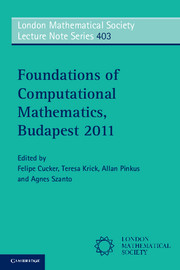Book contents
- Frontmatter
- Contents
- Preface
- Contributors
- 1 The State of the Art in Smale's 7th Problem
- 2 The Shape of Data
- 3 Upwinding in Finite Element Systems of Differential Forms
- 4 On the Complexity of Computing Quadrature Formulas for SDEs
- 5 The Quantum Walk of F. Riesz
- 6 Modulated Fourier Expansions for Continuous and Discrete Oscillatory Systems
- 7 The Dual Role of Convection in 3D Navier-Stokes Equations
- 8 Algebraic and Differential Invariants
- 9 Through the Kaleidoscope: Symmetries, Groups and Chebyshev-Approximations from a Computational Point of View
- 10 Sage: Creating a Viable Free Open Source Alternative to Magma, Maple, Mathematica, and MATLAB
- References
6 - Modulated Fourier Expansions for Continuous and Discrete Oscillatory Systems
Published online by Cambridge University Press: 05 December 2012
- Frontmatter
- Contents
- Preface
- Contributors
- 1 The State of the Art in Smale's 7th Problem
- 2 The Shape of Data
- 3 Upwinding in Finite Element Systems of Differential Forms
- 4 On the Complexity of Computing Quadrature Formulas for SDEs
- 5 The Quantum Walk of F. Riesz
- 6 Modulated Fourier Expansions for Continuous and Discrete Oscillatory Systems
- 7 The Dual Role of Convection in 3D Navier-Stokes Equations
- 8 Algebraic and Differential Invariants
- 9 Through the Kaleidoscope: Symmetries, Groups and Chebyshev-Approximations from a Computational Point of View
- 10 Sage: Creating a Viable Free Open Source Alternative to Magma, Maple, Mathematica, and MATLAB
- References
Summary
Abstract
This article reviews some of the phenomena and theoretical results on the long-time energy behaviour of continuous and discretized oscillatory systems that can be explained by modulated Fourier expansions: longtime preservation of total and oscillatory energies in oscillatory Hamiltonian systems and their numerical discretizations, near-conservation of energy and angular momentum of symmetric multistep methods for celestial mechanics, metastable energy strata in nonlinear wave equations. We describe what modulated Fourier expansions are and what they are good for.
Introduction
As a new analytical tool developed in the past decade, modulated Fourier expansions have been found useful to explain various long-time phenomena in both continuous and discretized oscillatory Hamiltonian systems, ordinary differential equations as well as partial differential equations. In addition, modulated Fourier expansions have turned out useful as a numerical approximation method in oscillatory systems.
In this review paper we first show some long-time phenomena in oscillatory systems, then give theoretical results that explain these phenomena, and finally outline the basics of modulated Fourier expansions with which these results are proved.
- Type
- Chapter
- Information
- Foundations of Computational Mathematics, Budapest 2011 , pp. 113 - 128Publisher: Cambridge University PressPrint publication year: 2012
References
- 4
- Cited by



